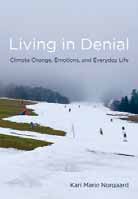SEJournal Online is the digital news magazine of the Society of Environmental Journalists. Learn more about SEJournal Online, including submission, subscription and advertising information.

BookShelf
Living in Denial: Climate Change, Emotions, and Everyday Life
By Kari Marie Norgaard
MIT Press, $25 (paperback)
Reviewed by MIRANDA SPENCER
The “denial” in this book’s title refers not to the rejection by politicians and pundits of the scientific facts of climate change.
Rather, it addresses the process by which people cope by distancing themselves from painful truths, what Norgaard — a professor of sociology and environmental studies at Whitman College — calls “knowing yet not knowing.”
She argues that this process — not lack of information or concern — causes emotional numbness at all levels, which may help explain the world’s inaction on the overwhelming reality of climate change.
Norgaard’s ideas are both insightful and accessible, if you’re patient with academic jargon. They come from her year-long (2000-2001) ethnographic study of the close-knit residents of an idyllic Norwegian town she calls Bygdaby (a pseudonym).
There, people don’t argue with the reality of the greenhouse effect: They can see it all around them during an unseasonably warm winter when snow comes two months late, disrupting their economy and culture.
Yet they barely broach the topic in conversation, much less organize around it, locally or nationally.
Through interviews with those she lived alongside and building on scholarship across the social sciences, Norgaard explains how Bygdaby folk figuratively pull their ski caps over their eyes on the issue of climate change, even though — like many other Norwegians — they are educated, environmentally conscious, and among the more politically astute who regularly read newspapers, march for human rights, and revere their mountains and fjords.
They have trouble reconciling their national self image as a simple, conscientious, and past-suffering people with the fact that their nation rivals Saudi Arabia in oil exports and the United States in per-capita CO2 emissions.
Essentially, processing the idea that they (and the rest of us) are both “perpetrators and victims” of a seemingly insurmountable environmental crisis is almost literally inconceivable.
As one resident told the author, people “want to protect themselves a little bit.”
Included is a “tool kit” for “collective actions ... taken to restore a sense of equilibrium and social stability,” including particularly local traditions of stoicism (not expressing messy feelings), good deeds (religiously recycling) and more universal excuses such as distractions (shopping to do; bills to pay) and diversion (at least we’re not as bad as those Americans!).
In the latter part of the book, Norgaard extrapolates her thesis to the rest of the “privileged” first world, particularly the United States, and makes a few recommendations for breaking the cycle she has described.
By the end of this critical-yet-compassionate book, American climate denialism almost makes sense.
What does Bygdaby have to do with journalism?
Quite a bit, though Norgaard doesn’t explicitly say so except to make the point that presenting more and better information via the news media is unlikely to change matters.
For one thing, her findings suggest that if we want our work to have impact, we should understand our audiences as socialized beings rather than simply individuals, and take into account the role of emotion in processing information (or not, if we’re not willing to receive it).
And to understand that “people judge as serious only those problems for which they think action can be taken.”
Miranda Spencer is an SEJ associate member who has freelanced for a variety of publications including E, American Forests, and The Daily Climate. She recently joined the staff of Environmental Health News as a morning researcher.
* From the quarterly newsletter SEJournal, Summer 2011 issue.













 Advertisement
Advertisement 



